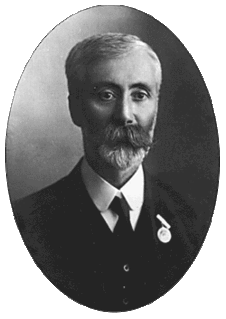
Joseph Henry Maiden was a botanist who made a major contribution to knowledge of the Australian flora, especially the genus Eucalyptus. This botanist is denoted by the author abbreviation Maiden when citing a botanical name.

Eucalyptus populnea, commonly known as poplar box, bimble box or bimbil box, is a species of small to medium-sized tree that is endemic to eastern Australia. It has rough, fibrous or flaky bark on the trunk and branches, egg-shaped, elliptical or more or less round leaves, flower buds arranged in groups of seven to fifteen or more, white flowers and conical, hemispherical or cup-shaped fruit.

Eucalyptus rubida, commonly known as candlebark, ribbon gum or white gum, is a species of small to medium-sized tree that is endemic to south-eastern Australia. It has smooth bark, sometimes with rough bark at the base, lance-shaped or curved adult leaves, flower buds in groups of three, white flowers and cup-shaped, hemispherical or bell-shaped fruit.
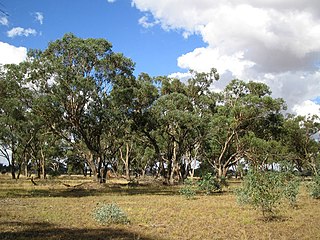
Eucalyptus microcarpa, commonly known as grey box, is a species of tree that is endemic to southeastern continental Australia. It has rough, fibrous or flaky bark on the trunk, smooth whitish bark above, lance-shaped adult leaves, flower buds in groups of between seven and eleven, white flowers and oval, cylindrical or urn-shaped fruit.

Eucalyptus woollsiana is a species of tree that is endemic to eastern Australia. It has rough, fibrous bark on the trunk, smooth bark above, lance-shaped adult leaves, flower buds in groups of five or seven, white flowers and cup-shaped fruit.
Dennis Considen was an Irish-born surgeon, best known for his pioneering role in the use of Australian native plants for pharmaceutical use, especially eucalyptus oil, which he used to treat the convicts. He sailed with the First Fleet as surgeon on the Scarborough, which transported English convicts to Port Jackson, Australia, in 1788.

Eucalyptus notabilis, commonly known as Blue Mountains mahogany or mountain mahogany, is a species of small to medium-sized tree endemic to eastern Australia. It has rough, fibrous bark on the trunk and branches, lance-shaped to curved adult leaves, flower buds in groups of between seven and eleven, white flowers and hemispherical or conical fruit.

Eucalyptus quadrangulata, commonly known as the white-topped box or coast white box, is a species of small to medium-sized tree that is endemic to eastern Australia. It has rough, fibrous or flaky bark on the trunk and branches, lance-shaped to curved adult leaves, flower buds in groups of seven, white flowers and conical fruit.

Eucalyptus conica, commonly known as fuzzy box, is a species of tree endemic to eastern Australia. It has rough, flaky bark on the trunk and larger branches, smooth above, lance-shaped adult leaves, oval to diamond-shaped flower buds mostly arranged on a branching inflorescence on the ends of the branchlets, white flowers and conical fruit.

Eucalyptus benthamii, commonly known as Camden white gum, Bentham's gum, Nepean River gum, kayer-ro or durrum-by-ang, is a species of tree that is endemic to New South Wales. It has mostly smooth bluish grey or white bark, lance-shaped to curved adult leaves, flower buds arranged in groups of seven, white flowers and cup-shaped, bell-shaped or conical fruit.

Eucalyptus approximans, commonly known as the Barren Mountain mallee, is a mallee endemic to a small area of New South Wales. It has smooth bark, linear to lance-shaped or curved adult leaves, club-shaped buds in groups of seven in the leaf axils, white flowers and cylindrical to cup-shaped fruit.
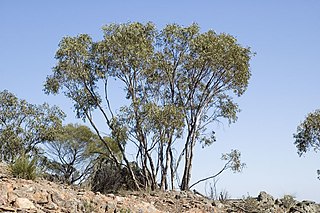
Eucalyptus dwyeri, commonly known as Dwyer's red gum or Dwyer's mallee gum, is a species of small tree, sometimes a mallee that is endemic to eastern Australia. It has smooth, white or cream-coloured bark, lance-shaped to curved adult leaves, flower buds in groups of seven and conical, bell-shaped or hemispherical fruit.

Eucalyptus rudderi, or Rudder's box, is a species of tree that is endemic to northern New South Wales. It has rough fibrous or flaky bark on the trunk and branches, lance-shaped adult leaves, flower buds in groups of seven, white flowers and barrel-shaped or hemispherical fruit.

Eucalyptus staeri, commonly known as Albany blackbutt, is a species of small tree or a mallee and is endemic to the south-west corner of Western Australia. It has rough bark on the trunk and branches, thick, lance-shaped adult leaves, flowers buds in groups of between seven and fifteen, creamy white flowers and shortened spherical fruit.
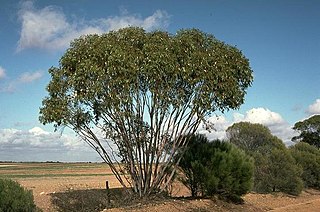
Eucalyptus stowardii, commonly known as fluted-horn mallee, is a species of mallee that is endemic to the south-west of Western Australia. It has smooth bark, lance-shaped adult leaves, flower buds in groups of seven, creamy white flowers and ribbed, cylindrical to cup-shaped fruit.

Eucalyptus camfieldii, commonly known as Camfield's stringybark or heart-leaved stringybark, is a species of mallee or small tree that is endemic to New South Wales. It has rough, fibrous and stringy bark, broadly lance-shaped adult leaves, flower buds in groups of about eleven, white flowers and flattened hemispherical fruit. It grows in poor, sandy soil in the Sydney region.

Eucalyptus microneura, commonly known as Gilbert River box, is a species of small to medium-sized tree that is endemic to Queensland. It has rough, fibrous or flaky bark on the trunk and branches, lance-shaped adult leaves, flowers in groups of seven on a branching peduncle, white flowers and conical fruit.
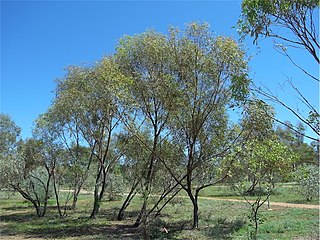
Eucalyptus normantonensis, commonly known as Normanton box, is a species of mallee, rarely a small tree, that is endemic to northern Australia. It has rough, fibrous or flaky bark on some or all of the stems, lance-shaped to curved adult leaves, flower buds in groups of between seven and eleven, white flowers and cylindrical, barrel-shaped or shortened spherical fruit.

Acacia pilligaensis, commonly known as Pillaga wattle or pinbush wattle, is a tree or shrub belonging to the genus Acacia and the subgenus Phyllodineae native to eastern Australia.
Eucalyptus × kalangadooensis is a species of tree that is endemic to a small area in South Australia. It has smooth bark, lance-shaped adult leaves, flower buds in groups of between four and ten and top-shaped fruit. It is thought to be a hybrid between E. camaldulensis subsp. camaldulensis and either E. ovata or E. viminalis subsp. cygnetensis.



















